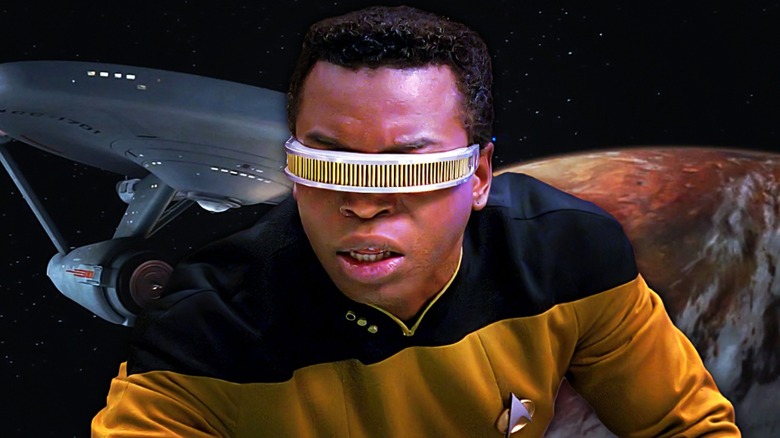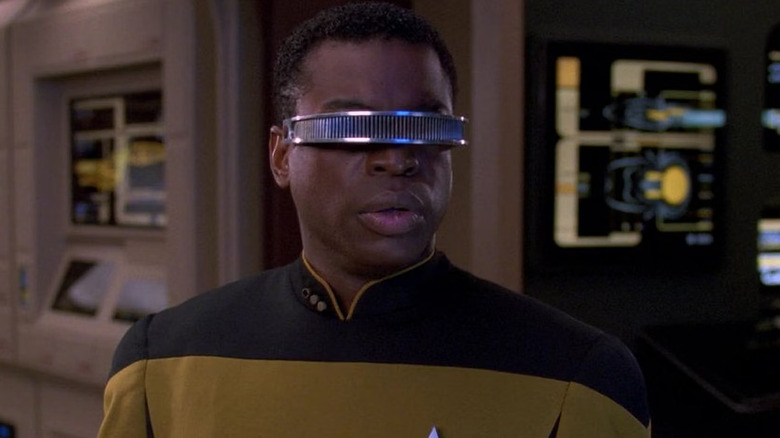Star Trek's LeVar Burton Had A Difficult Time With Geordi La Forge's Visor
One of the more hopeful aspects of the notoriously optimistic "Star Trek" is that in the future, all disabilities will be readily and easily accommodated. While one might argue that the miracle technologies at hand in "Star Trek" might be able to undo any and all disabilities, employing them would raise sticky moral issues for the audience. How many disabilities would the writers of "Star Trek" be "correcting" before the show starts to reek of eugenics?
Instead, anyone with a disability is merely given an appliance or prosthesis that allows them to work in Starfleet without anyone making an issue of it. Case in point: Geordi La Forge, the engineer played by LeVar Burton on "Star Trek: The Next Generation," was born blind, lacking irises or pupils. In order to see, Geordi wears an over-the-eyes appliance called a VISOR that hooks onto small implanted neural sensors located at his temples. The VISOR takes in visual information and feeds it directly into Geordi's brain, bypassing his eyeballs completely. His vision is mostly thermal, giving Geordi a different kind of visual information than most people.
In a few early episodes of "Next Generation," characters discuss the way Geordi's VISOR works, but before too long, everyone stopped mentioning it. It was just a part of the show. Indeed, on the rare instances when a visiting dignitary asked Geordi about his VISOR, he would get annoyed, just as someone might when asked personal questions about their wheelchair.
On the set of "Next Generation," however, the VISOR had the opposite effect as its fictional description. The actual VISOR appliance Burton had to wear actually blocked off a great deal of his vision, making some of his scenes hard to nail. Also, Burton had to learn to act without his eyes, likely a challenge for any actor. Back in 2007, in an interview with BBC Two, Burton talked about wearing his VISOR on set, and he described it as "a living Hell."
A living Hell
It took LeVar Burton the better part of the show's 1987 first season to get used to wearing the VISOR. He also noted that he didn't want to get used to it, as he was confident the series would fail, he'd quickly be out of work, and he wouldn't have to worry about the VISOR. The irony of a fictional device said to enhance vision actually blocking his own wasn't lost on Burton. He said:
"It's pretty much a living hell. 85 to 90% of my vision is taken away when the VISOR goes on. I bumped into everything the first season; light stands, overhead microphones, cables at my feet. I tripped over it all. So it's a sort of conundrum. The blind man, who puts on the VISOR and sees much more than everyone else around him, when the actor actually does that he's turned into a blind person."
One might assume the VISOR was a lightweight appliance that was merely spirit-gummed onto Burton's temples. That might have been true for the first season, but the makeup artists came up with something much more convincing — and much more painful — for the second season. The new VISOR was a hunk of metal that clamped onto Burton's temples, squeezed tightly onto his head. It may have stayed affixed, but Burton noted that after a long day of shooting, it began to hurt. He continued:
"In the second season, we re-designed the VISOR and made it heavier and the way we actually affixed it was that we screwed it, we literally screwed it into my head. So there were screws that we would turn, and there were flanges on the inside that would press into my temples. So after fifteen or twenty minutes of that, I got headaches. So, I had a daily headache for about six years. Which was also no fun."
Burton wasn't given a reprieve from the VISOR until "Star Trek: First Contact" in 1996. By then, working mechanical eyeballs had been invented, and Geordi had a pair implanted. One can only imagine the relief Burton felt after a decade of pain.

